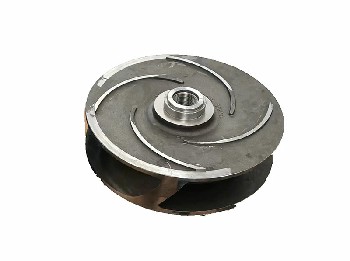What is a Pump Impeller?
A pump impeller is a rotating component within a pump that transfers mechanical energy from the motor to the fluid being pumped. It consists of blades or vanes that rotate and create flow by exerting centrifugal force on the fluid.
Types of Pump Impellers
Open Impellers
Open impellers have vanes that are attached to a central hub, and their design is relatively simple. They are suitable for handling clean fluids but may not be as efficient as other types.
Closed Impellers
Closed impellers enclose the fluid within the impeller itself, with only the inlet and outlet openings. They are known for their high efficiency and are commonly used in industrial applications.
Semi-Open Impellers
Semi-open impellers have vanes attached to a backing plate, leaving one side open. They are commonly used in wastewater treatment and handling liquids with a high solids content.
Multi-Stage Impellers
Multi-stage impellers consist of multiple impellers stacked together on a common shaft. They are used in applications requiring high pressure and are often found in high-rise building water systems.
The Role of Pump Impellers in Fluid Transfer
Centrifugal Force and Impeller Action
As the impeller rotates, the fluid is drawn into the eye of the impeller and accelerated outward by centrifugal force, creating a low-pressure area at the center.
Creating Pressure and Velocity
The high-velocity fluid is then directed into the volute or diffuser, where it converts its kinetic energy into pressure energy.
Impeller and Pump Efficiency
The efficiency of a pump largely depends on the design and condition of the impeller, as it directly influences the energy transfer and fluid flow within the system.
Construction and Components of Pump Impellers
Materials Used
Pump impellers are typically made from materials like stainless steel, cast iron, bronze, or composite materials depending on the application's requirements.
Blade Geometry
The shape, size, and curvature of the impeller blades significantly impact the pump's performance and efficiency.
Balancing and Shaft Connection
Proper balancing of the impeller and secure shaft connection are crucial to prevent vibrations and ensure smooth operation.
Factors Affecting Pump Impeller Performance
Diameter and Size
The diameter and size of the impeller determine the pump's flow rate and head generation capabilities.
Speed and RPM
The rotational speed, measured in revolutions per minute (RPM), affects the pump's efficiency and performance.
Cavitation and NPSH
Cavitation occurs when the pressure in the pump drops too low, forming vapor bubbles that can damage the impeller. The Net Positive Suction Head (NPSH) is crucial to prevent cavitation.
Viscosity and Temperature
Fluid viscosity and temperature influence the impeller's ability to transfer energy and affect pump efficiency.

Selecting the Right Impeller for Pump Applications
Matching Impeller Types to Fluid Characteristics
Understanding the fluid's properties is essential for choosing the most suitable impeller type.
Considering Operating Conditions
The pump's operating conditions, such as flow rate and pressure requirements, must be taken into account during impeller selection.
Efficiency and Performance Curves
Analyzing the impeller's performance curves helps in determining its efficiency over various operating conditions.
Maintenance and Troubleshooting
Regular Inspection and Cleaning
Periodic inspection and cleaning of the impeller help maintain its performance and extend its lifespan.
Identifying Wear and Damage
Detecting signs of wear or damage in the impeller early on can prevent costly breakdowns and system failures.
Common Impeller Issues and Solutions
Understanding common impeller-related problems and their solutions is crucial for smooth pump operation.
Innovations and Future of Pump Impellers
Advancements in Materials
Ongoing research aims to develop advanced materials that offer better performance and durability.
Improving Energy Efficiency
Engineers are continually working to enhance impeller designs to improve overall pump energy efficiency.
Digital Monitoring and Predictive Maintenance
The integration of IoT and advanced monitoring systems allows real-time monitoring of pump performance, enabling predictive maintenance.
Where to buy pump impellers?
Authorized by the National Department of Foreign Economic Relations and Trade, Shijiazhuang Jinjieber Imp.& Exp. Co. Ltd specializes in hardware, construction materials, steel, light industrial and chemical products, machinery, and electronic equipment.
Impeller Pump Parts CD4MU
 English
English
![]()
 English
English
 Russian
Russian
 French
French
 Spanish
Spanish













